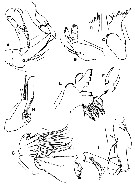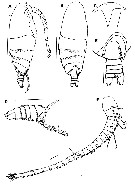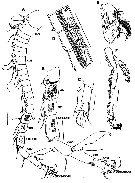|
|
 |
|
Calanoida ( Order ) |
|
|
|
Ryocalanoidea ( Superfamily ) |
|
|
|
Ryocalanidae ( Family ) |
|
|
|
Ryocalanus ( Genus ) |
|
|
| |
Ryocalanus squamatus Renz, Markhaseva & Laakmann, 2018 (F,M) | |
| | | | | | | Ref.: | | | Renz & al., 2018 (p.6, Descr.F, M, figs.F, M, mol. biol., phylogeny) |  Issued from : J. Renz, E.L. Markhaseva & S. Laakmann in Zool. J. Linnean Soc., 2018, XX. [p.7, Fig.1] Female (from 40.5808°N, 150.9833°): A-B, habitus (dorsal and lateral, respectively); C, rostrum (ventral); D, prosome posterior corners and urosome (lateral); E, urosome (ventral); F-H, paratype, prosome posterior corners and urosome (dorsal), ventral and lateral, tespectively); I, A1; J, segment XXVII-XXVIII of A1; K, scales on segment VIII-XI of A1. Scale bars: A-I, K: 0.05 mm. Nota: - Prosome 4.8 times as long as urosome. - Rostrum stout and strong, one-pointed. - Cephalosome and pediger 1 partly fused, pedigers 4-5 separate. - In lateral view, posterolateral corners of prosome extending posteriorly into points, reaching to middle of genital double-somite. Pedigers 2-5 covered with fine spinules. - Urosome 4-segmented. Genital double-somite and urosomites covered with rows of fine spinules. - Genital double-somite slightly asymmetrical,, with lateral swelling on left side and ventomedial opening; in lateral view genital double-somite swollen ventroanteriorly. Seminal receptacles of oval shape. - Caudal rami symmetrical with 2 lateral setae (II and III), 3 terminal setae (IV-VI) and 1 dorsal seta (VII). - A1 24-segmented, extending to pediger 2, covered with scale-like structures.
|
 Issued from : J. Renz, E.L. Markhaseva & S. Laakmann in Zool. J. Linnean Soc., 2018, XX. [p.8, Fig.2] Female: A, A2 (dotted seta added after paratype); B, Md palp; C, Md gnathobase; D, paratype, cutting edges of Md gnathobase; E, Mx1; F, paratype, Mx1 praecoxal arthrite seta in different positions; G, Mx2; H, paratype, Mx2 basal endite and endopod; I, Mxp. Scale bars: A, H: 0.05 mm; B-D0, I: 0.1 mm. Nota: - Endopod 2-segmenyed; exopod incompletely 8-segmented (setal formula: 1, 3, 1, 1, 1, 1, 1, 3). - Md: Gnathobase cutting edge with 7 unequal teeth plus ventral seta; exopodal segments with 6 setae; 1st endopodal segment with 2 setae, 2nd segment with 11 setae. Exopod to endopod ratio 0.82. - Mx1: praecoxal arthrite with 9 terminal spines, 4 posterior and 2 anterior setae; coxal endite with 6 setae, coxal epipodite wiyj 9 setae; proximal basal endite with 4 setae, distal basal endite with 5 setae; endopod with 15 setae; exopod with 11 setae. - Mx2: proximal praecoxal endite bearing 4 setae plus attenuation in holotype, 5 setae plus attenuation in paratype, distal praecoxal endite with 3 setae; coxa without outer seta, coxal endites with 3 setae each; proximal basal endite with 4 setae; endites 2-5 with surface spinules, remaining endopod with 8 setae. - Mxp: syncoxa with 1 seta on praecoxal endite, 2 setae on proximal coxal endite, 3 setae on middle coxal endite, and 3 setae on distal coxal endite; syncoxa with fine rows of spinules; basis with 3 distal setae; endopod 6-segmented (setal formula: 2, 4, 4, 3, 3, 4 setae). Rem. : In both sexes, the distal spine on the praecoxal arthrite of Mx1 shows a cavity at its tip, presumably a specific adaptation connected with feeding. This structure is observed in R. bowmani (see figure in this species. A morphologically similar structure can be found in the Md of Heterorhabdidae (see Ohtsuka & al., 1997). Some variability was observed in the armature of the proximal praecoxal endite of Mx2 between right and left limb of individuals in both female and male specimens (i.e. presence of 4 or 5 setae). Furthermore, this endite was always equipped with a short attenuation in females (a feature not reported before in other ryocalanid species).
|
 Issued from : J. Renz, E.L. Markhaseva & S. Laakmann in Zool. J. Linnean Soc., 2018, XX. [p.9, Fig.3] Female: A, P1 (with endopod figured separately); B, P2; C, P3; D, rioght P4; E, left P4. Scale bars: A-E: 0.1 mm.
|
 Issued from : J. Renz, E.L. Markhaseva & S. Laakmann in Zool. J. Linnean Soc., 2018, XX. [p.12, Table 3] Female & Male: Seta and spine formula from Kurile-Kamchatka Trench. Nota: Abnormalities were observed in the formation of a swimming leg, as in one female and one male specimen, exopods of P4 and P2, respectively, lacked lateral spines, and exopodal segment 3 lacked the terminal spine and deviated in the setation typical for this taxon.
|
 Issued from : J. Renz, E.L. Markhaseva & S. Laakmann in Zool. J. Linnean Soc., 2018, XX. [p.710, Fig.4] Male (from 41.2000°N, 150.0833°E): A, habitus (lateral); B, habitus (dorsal), specimen damaged; C, rostrum (ventral view); D-E, posterior prosome and urosome (lateral and dorsal, respectively); F, left A1. Scale bars: A-B, 0.5 mm; C-D: 0.1 mm. Nota: - Prosome 4.6 times as long as urosome. - Rostrum stout, strong, one-pointed. - Cephalosome andpediger 1 separate, pedigers 4 and 5 separte. - Pedigers 2-5 covered with fine spinules.
Caudal rami slightly asymmetrical, with 1 lateral seta (III), 3 terminal setae (IV-VI) plus 1 dorsal seta (VII).
- Left A1 unmodified, 24-segmented, extending to pediger 2, covered with scale-like structures.
- A2, Md, Mx1, Mxp similar to those of female.
- Mx2 as in female, with proximal praecoxal endite bearing 4 or 5 setae, but without attenuation.
|
 Issued from : J. Renz, E.L. Markhaseva & S. Laakmann in Zool. J. Linnean Soc., 2018, XX. [p.11, Fig.5] Male: A, right A1; B, right A1 (segments XIX-XXVIII); C, right A1 (segments XXVI-XXVIII); D, right A1 (segments XVII-XIX, different position );E, P4 (coxa and basis); F, P5. Scale bars: A-B, D-F: 0.1 mm; C: 0.05 mm. Nota: - Right A1 strongly modified for grasping, 23-segmented; segments XX to XXVI wider than on the left, segments XX to XXII-XXIII with surface spinules, segments XX and XXI with 1 proximal spine each; segments XXV and XXVI with strong lateral attenuations proximally, wegment XXII-XXIII fused;, hingesd occirring between segments XIX and XX, XX and XXI, and XXIII-XXIII and XXIV. - P5 uniramous on both sides, covered with rows of spinules on posterior surface. Right leg with exopod 1-segmented, shorter than left leg, with terminal spine/ Left leg with exopod 3-segmented, terminal segment with 2 spines.
| | | | | NZ: | 1 | | |
|
Distribution map of Ryocalanus squamatus by geographical zones
|
| | | | Loc: | | | NW Pacif. (Kurile-Kamchatka Trench)
Type locality: 40.5808° N, 150.9833° E. | | | | N: | 1 | | | | Lg.: | | | (1223) F: 2,05-2,17; M: 1,83; {F: 2,05-2,17; M: 1,83} | | | | Rem.: | Hyperbenthic (above the sea bed: 5251 m, 5400 m).
For Renz & al. (2018, o.12) this species differs from all other Ryocalanus by the shape of the rostrum, which is short and stout and an only slightly asymmetrical genital double-somite; also, pedigers 2-5, as well as the anterior part of the legs are covered in fine spinules, which are absent in other Ryocalanus females, and the coxa of P4 lacks the robust spines . The A1 is covered with scale-like structures, a character not detected so far in any other species of Ryocalanus. A2 exopod to endopod ratio is 0.82, while in all other species it is close to 1, a character hypothesized to be diagnostic for the genus Ryocalanus (Renz & al., 2013).. | | | Last update : 30/03/2019 | |
|
|
 Any use of this site for a publication will be mentioned with the following reference : Any use of this site for a publication will be mentioned with the following reference :
Razouls C., Desreumaux N., Kouwenberg J. and de Bovée F., 2005-2025. - Biodiversity of Marine Planktonic Copepods (morphology, geographical distribution and biological data). Sorbonne University, CNRS. Available at http://copepodes.obs-banyuls.fr/en [Accessed October 15, 2025] © copyright 2005-2025 Sorbonne University, CNRS
|
|
 |
 |









